Band of three of the remaining four Grateful Dead members truck on.
For those who care enough to want a clarification but lack actual interest to dig for themselves, The Grateful Dead, as a band, commenced in 1965 and ended in 1995 when reluctant leader Jerry Garcia died. While splinter groups of original members came and went, the final performances of the collective celebrated the 50th anniversary of the band. Dubbed Fare Thee Well (a line taken from fan favourite, Brokedown Palace) in 2015. Following these shows, two separate musical entities split to continue the Dead legacy on divergent paths. Drummers Bill Kreutzman and Mickey Hart, along with guitarist and singer, Bob Weir formed the Dead part of Dead and Company. Bassist Phil Lesh chose to step away from the large stadium and arena touring machine and focus on leading his namesake band, Phil and Friends. The Grateful Dead may be dead but the music not only has remained, year after year since Garcia’s death Deadhead numbers have sweeled to more now than ever before.
The Dead in D&C clearly refers to the original members of the band. On the Company side of Dead & Company is bassist Oteil Burbridge (formerly of the Allman Brothers Band, Tedeschi Trucks Band and Aquarium Rescue Unit), keyboardist/pianist Jeff Chimenti (a long-time player in Bob Weir’s side projects and many post-GD member bands) and the most global star in the band, John Mayer on guitar and vocals. Following the Fare Thee Well shows, the announcement of Dead and Company raised many eyebrows due to Mayer’s inclusion. While recognized as a skilled singer, songwriter and guitarist, the idea of a pop star out front with the remnants of one of the most subversive, storied and psychedelic American bands seemed puzzling.
The new origin story goes that a few years after discovering and falling deeply in love with the catalogue of the Grateful Dead, Weir and Mayer met as guest and guest host on The Late Late Show. A studio performance of Althea and Truckin’ prompted Weir to continue his musical relationship with Mayer. Meeting back following Fare Thee Well, Mayer had taken the time to rehearse much of the song list, enough that Dead & Company played their first show on Halloween 2015. Originally planned as a one-off, the band’s first tour was announced soon after. Thus began a history that continues and grows to this day.
Starting with a tour opener at LA Dodger’s Stadium, the west coast swing included two nights at the Grateful Dead outdoor stronghold, Shoreline Amphitheatre outside San Francisco. The tour rolled into another historical Dead venue, Folsom Field on the University of Colorado campus in Boulder. The Grateful Dead played the enormous 50,000-capacity football field in 1972. Then celebrated their 15th anniversary there in 1980. However, Dead and Company tallied their 9th and 10th shows at the stadium on June 17 and 18. A 34-years long and counting Deadhead, I decided they couldn’t be missed and wrapped a mini solo vacation around two shows.
Ringed by a gorgeous vista of the sun setting on the Flatirons, Mayer stepped to the mic to open the run with the classic Bertha. Next was Weir’s turn with a cover of The Young Rascals’ Good Lovin’, an homage to founding member and former frontman Ron ‘Pigpen’ McKernan. On the 50th anniversary of the bluesman’s final show with the Grateful Dead prior to his death in 1972, D&C ran through two more from the Pig’s common repertoire, Howlin’ Wolf’s Smokestack Lighting and Mr. Charlie. The set moved through slinky Deadhead faves like Ramble On Rose and They Love Each Other. The sight of 40,000 people dancing to the song was one to behold. Vocal duties were then handed over to Oteil Burbridge. A rarer played tune, the bassist delivered a lovely rendition of High Time from the 1970 album Workingman’s Dead. The second set opened with the Garcia classic Sugaree, sung soulfully by John Mayer. A run through Dead standard Truckin’ set the crowd dancing hard among other songs before landing in the land of psychedelia with The Other One. Transitioning into the freest portion of the night, drummers Kreutzmann and Hart stepped to The Beast, the massive drum collection used solely for this improvised percussive solo. Burbridge joined the duo as they played out into the heartfelt ballad Wharf Rat. After another nod to fallen member Pigpen with a rare cover of Bobby ‘Blue’ Bland’s Turn On Your Love Light, the first night closed with the grooving radio-hit Casey Jones, arguably the band’s greatest earworm.
Before detailing the second night, it’s impossible to talk about Dead and Company without delving into some things, for this article’s sake, I’ll cover jam bands and go deeper on John Mayer’s D&C membership in the Company.
As mentioned, Mayer’s addition seemed the oddest. Burbridge and Chimenti had decades of experience in the very broad defined omnigenre of ‘jam band’. To include a blues rocker pop star emerging from a time defined more by controversy than hits, even one with indisputable talent, turned out to be a wise and revelatory move by Weir. It took a few years of foot-finding, but what Mayer eventually developed into within Dead and Company was as much an engineer as any other member. While many lifelong students of Garcia can beautifully combine a storehouse of his licks and tones with a creative mind, their study guide was clearly defined and available. What Mayer has brought to this music is more akin to what Jerry Garcia brought originally – years of dedicated practice and playing within different styles from a variety of influences. Not to say that one of Mayer’s latest and deepest influences isn’t the late founding guitarist. Where Mayer’s detractors hit a solid earth complaint is that perhaps he brings too much blues-rock styling to the band. Despite the Grateful Dead having originating roots in electric blues, Mayer’s style is pulled more from Stevie Ray Vaughn, Jimi Hendrix and Eric Clapton, whereas Garcia took his blues notes from Rev. Gary Davis, Robert Johnson, Mississippi John Hurt and Blind Blake.
In the early days of D&C, it was easier to dismiss Mayer and group as nothing more than a cover band, which of course, they are. However, what sets any Grateful Dead cover band apart is that by playing these songs, they reenter an experiment, study and journey that began in 1965. Part of Mayer’s influence in this continuation that I see is pulling even more melody out of these great songs. Sure, at first, hearing him sing a song that Jerry Garcia was best known for in the voice that told high school girls that their bodies were wonderlands took getting used to. But where this group is now taking this music with Mayer, is obviously pleasing a lot of Deadheads. And creating them. The full stadiums that Dead and Company are enjoying would most likely not be packed without his involvement. Whether his star power has aimed a larger spotlight on the music of the Grateful Dead or has converted large numbers of his solo work supporters, the fan growth is hard to deny. Staunch and stern Heads who refused to accept any facsimile following Jerry’s death may not care about this musical tribute’s rise. But judging from the large crowds being drawn, this population isn’t making a dent in anyone’s fun and success.
As a Deadhead myself, I was a bit baffled when I first heard of this pairing. My opinion of Mayer had been at the lowest, detached. However, I did enjoy his song, City Love back in the day (I urge you to listen to the music at this link. If you watch it, you’ll be subjected to Mayer before he had the psychic surgery that removed his cringy rock faces). His tabloid celebrity playboy splashes repelled me, but watching his Oxford Union talk from 2013 showed me that there was more to this artist than smarmy pop songs for crushing girls and their moms and sensationalist headlines. While his technical and artistic guitar talent has always been beyond reproach (despite personal tastes), knowing that now, a wiser, painfully self-aware, sober but funny Mayer is the one we see, for many, removes the shackles of his former guilty pleasure status. In spite of the smooth 80s vein of his latest album Sob Rock, bros can now freely admit their like of JM. From a guitar-playing standpoint, Mayer does tend to shift songs toward his bluesy origins, whereas if Garcia ever sat noticeably deep in a pentatonic blues scale, by the time you mentioned it he had teleported to different coordinates. Perhaps the biggest strength of Dead and Company is that they’ve evolved to be a reexamination of the music without the commonly-heard rote mimicry. They are full of jams but peacefully meander instead of rocketing through the roof. And that’s not a bad thing. It’s different. Which is one of many simple words that describe this music.
Details on night two and a chat about jam bands coming up in part two.
- Oteil Burbridge of Dead and Company. Photo by Aron Harris
- John Mayer of Dead and Company. Photo by Aron Harris
- Bob Weir of Dead and Company. Photo by Aron Harris
- John Mayer of Dead and Company. Photo by Aron Harris
- Jeff Chimenti of Dead and Company. Photo by Aron Harris
- Bob Weir and Mickey Hart of Dead and Company. Photo by Aron Harris

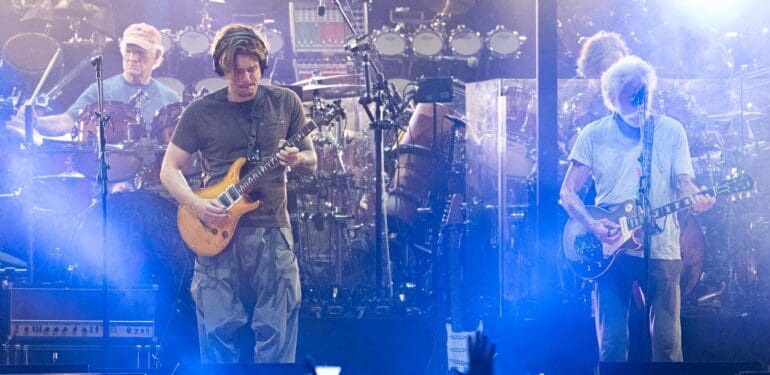
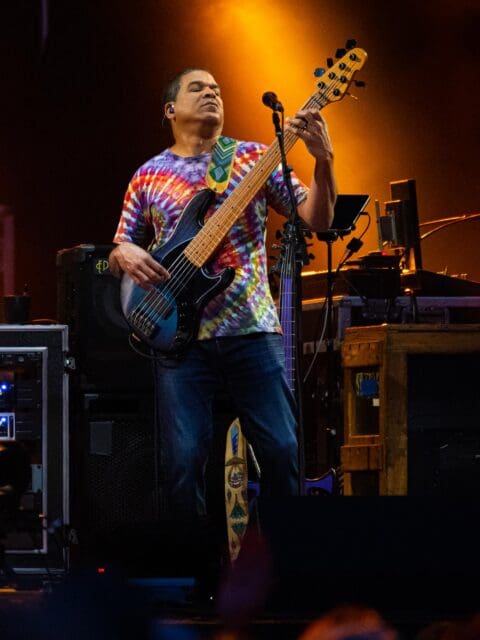
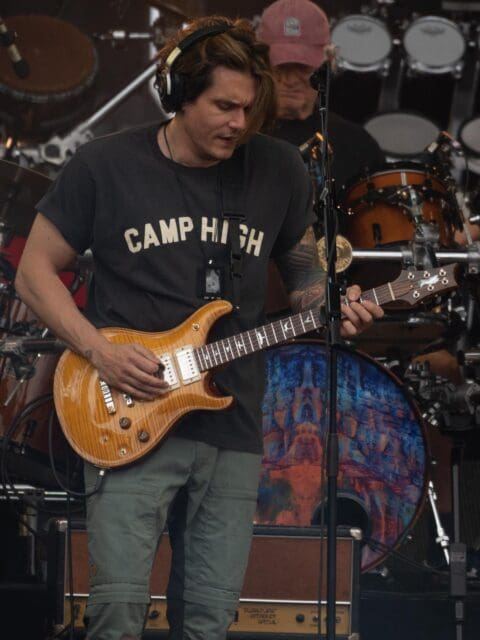
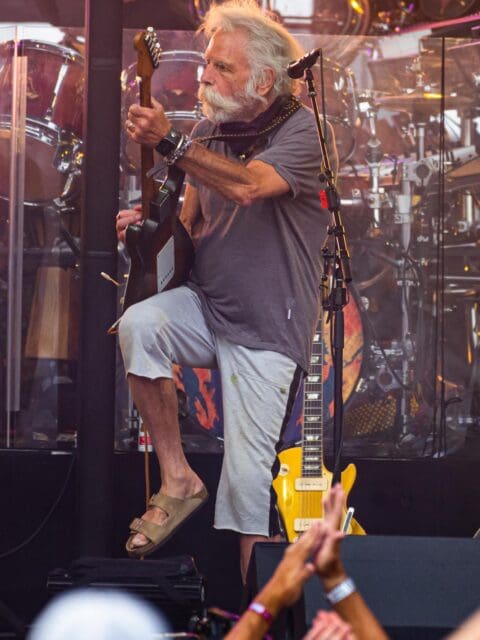

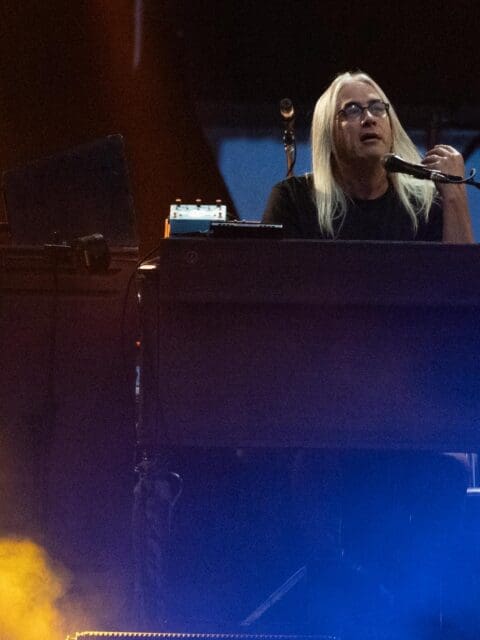
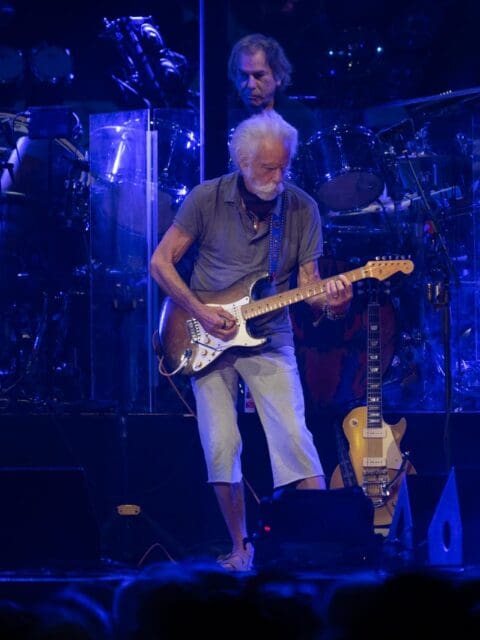

Pingback: Dead and Company Play Historic Folsom Field in Boulder, CO – PART TWO |ADDICTED